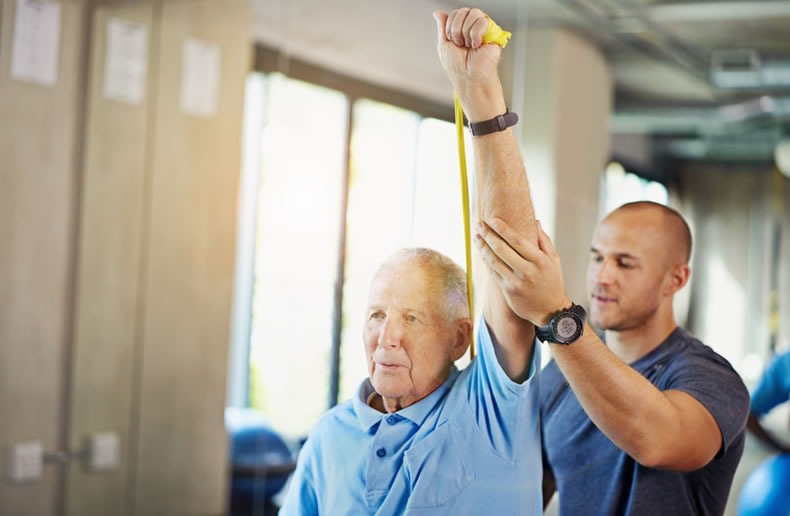By: Marie Serrado
As we age, it is natural to experience a decline in mobility, function, and overall quality of life. However, physical therapy becomes a vital component of seniors’ lives, as it empowers them to overcome challenges and obstacles associated with aging. This blog will explore the wide-ranging benefits of physical therapy for older adults.
- Enhancing Mobility:
Assessment and Individualized Treatment Plan: With physical therapy, your physical therapist first needs to conduct comprehensive assessments to evaluate what may be the issue. Whether it is because of the individual’s mobility limitations, balance, strength, or flexibility, once your physical therapist knows what the problem can be, they create an individualized treatment plan to target those mobility goals and challenges.
Therapeutic Exercise: A physical therapist can prescribe various therapeutic exercises that can help improve mobility in older adults. Therapeutic exercises involve movement prescribed to correct impairments, restore muscular and skeletal function, or maintain a state of well-being. (Bielecki JE, Tadi P, 2020). The most common forms of exercise would fall under four groups;
-
- Strengthening exercises: performed with heavy resistance but fewer repetitions.
- Endurance exercises: target larger muscle groups
- Flexibility: which helps with strengthening and movement
- Balance and Coordination exercises: help maintain the individual’s centre of gravity, (COG of the human body is a hypothetical point around which the force of gravity appears to act.)
Targeting specific areas of weakness or limitations, these exercises help seniors regain mobility and perform daily activities more efficiently.
Gait Training:
According to BellaVistaHealth.com, gait training “is a type of physical therapy that aims to improve strength and balance on your lower body so that you can walk safely and normally. Some gait exercises that are essential for elderly adults are:
-
- Heel Raises: Start in a seated position in a chair, with your feet flat on the floor. Point your toes to raise your heels. Do this ten times. This helps increase strength in your calf muscles, balance, and ankle mobility.
- Toe Raises: Start in a seated position in a chair, with your feet flat on the floor. Raise your toes off the ground while keeping your heels connected to the floor. Do this ten times. This helps with ankle mobility and balance and strengthens the shin and ankle muscles.
- Step-overs / side-stepping / figure eights: Place two soft objects on the floor about 3 feet apart. Step over each object several times. Be sure they’re placed at a distance where you naturally step over them with each foot. For side stepping, lift your foot and step sideways over each obstacle several times, leading with each foot an equal number of times. For figure eight, walk around the obstacles in figure eight movements. This helps keep the body in proper movement and lowers the risk of tripping over obstacles.
Assisted Devices: Physical therapists can also recommend and educate older adults on using assisted devices, such as canes and walkers, to help improve mobility and reduce the risks of falling.
Balance and Fall Prevention:
Improving balance and aiding in fall prevention is the most important thing for an older adult. Falls can be led to serious injuries and harm one well being. Physical therapists are crucial in addressing balance issues and helping create a fall prevention strategy. Many factors can cause a fall, including age-related muscle mass issues called sarcopenia and problems with balance and gait.
Sarcopenia is a decline in muscle mass, strength, and function. Its most likely to occur in people with chronic diseases and may contribute to a risk of falls, fractures, other serious injuries, and premature mortality. Poor nutrition and lack of exercise can increase the odds of developing sarcopenia.
Some fall prevention strategies include: staying active, improving balance and strength training, standing up slowly, checking your vision, and more.
By addressing balance concerns and implementing fall prevention strategies, physical therapy empowers older adults to maintain their independence and reduce the risk of injuries. It allows them to engage in daily activities confidently, navigate their environments safely, and enjoy a higher quality of life.
In conclusion: As we get older, it’s natural that our body begins to decline. However, having a physical therapist offers numerous benefits for older adults, including improved mobility, enhanced balance, and an overall better quality of life. Physical therapy allows older adults to continue living their best lives while ensuring they are safe.
If you or a loved one are facing these challenges, consider consulting with a physical therapist to develop a personalized plan that addresses your unique needs and goals.





